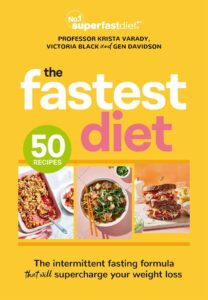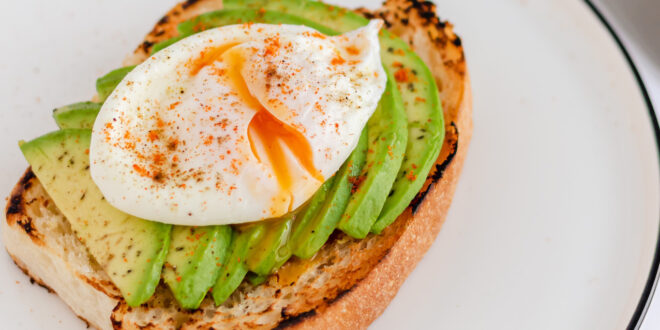 Article extracted from The Fastest Diet by Professor Krista Varady, Victoria Black, Gen Davidson, Macmillan Publishers, RRP $44.99
Article extracted from The Fastest Diet by Professor Krista Varady, Victoria Black, Gen Davidson, Macmillan Publishers, RRP $44.99
Not sure what to eat when it comes to feeling full and choosing JERF foods? See our top 10 choices to make it super easy.
Eggs
Eggs are a great satiating food because of their high protein content. They’re also a great source of biotin (aka vitamin B7), which is important for the body to be able to break foods down into their nutritious little bits during digestion. Eggs are also a good source of vitamin A that supports white blood cell production and healthy bones. A medium boiled egg contains approximately 77 calories, making eggs a handy hungersaving and low-calorie snack. Plus you can take them anywhere! – although we bags not sitting next to you on the bus.
Avocados
Avocados are one of the best plant-based sources of healthy (monounsaturated) fats around and can improve blood cholesterol and ease infl ammation. They also contain potassium (essential for cell hydration), magnesium (important for loads of chemical functions in the body) and folate (important for producing healthy red blood cells). Avocados are also rich in vitamins E, C and K, B vitamins and antioxidants. They are caloriedense (approximately 300 per avocado), but if you add them to meals as slices, they make up for it with their nutritional magic.
Yoghurt
Yoghurt has been a diet staple for yonks! It’s rich in protein and calcium, which is vital for healthy bones, muscles and nerve functions. It’s also rich in ribofl avin, a B vitamin that’s important for cell growth, and vitamin B12 that keeps your brain and nerve cells functioning. Yoghurt is versatile and can be added as a healthier alternative to cream in soups, dolloped on Mexican foods in place of sour cream, or served with fruits as a creamy dessert. Opt for non-fl avoured, plain yoghurt like Greek yoghurt as there are generally fewer added calories. If you want to fl avour your yoghurt, do so with fresh fruit instead. Or honey. Mmm mmm.
Oats
Oats are an excellent source of fi bres that are great for gut health and keep you feeling fuller for longer. One of these fi bres is beta-glucan, which can also help clear cholesterol from your body. Oats contain phenolic compounds and phytoestrogens that can have an antioxidant effect on the body and reduce infl ammation. Look for the least processed (like oat bran) as instant versions sometimes contain added sugar. #oats=goodbloat
Kale
Once the superfood du jour and for good reason. Kale contains vitamins K, C and A, B vitamins, folate and fi bre. It’s a cruciferous vegetable, and others in this group (bok choy, broccoli, caulifl ower, cabbage and brussels sprouts) are worthy of this list too. This is because they contain glucosinolates that get broken down into compounds that can reduce infl ammation and protect healthy cells. Like most vegies, kale is low-cal at only 34 calories per cup. Try baking the leaves in the oven with a little sea salt. Totally delicious, trust us.
Apples
A humble classic. Apples are a great source of fi bre and vitamin C. They also contain quercetin, a chemical that has antioxidant and anti-infl ammatory effects. Apples are also a good source of pectin, a fi bre that helps with digestion and may also help lower ‘bad’ LDL cholesterol. An apple a day really does keep the doctor away when it comes to you know … fl ushing your digestive system clean. Ahem. Just be sure you keep the skin on because that’s where a lot of the goodness – and happy inner plumbing – comes from!
Mushrooms
Historically, mushrooms have been used medicinally because of their healing properties. (Not that kind of medicinal use. Behave.) Now we know that mushrooms contain loads of healthy nutrients like B vitamins, potassium, selenium (good for DNA and healthy thyroid function), vitamin D (crucial for bone health) and phosphorus (helps regulate muscle and nerve function). Mr Mushroom is also very low in calories at only 15 calories per cup, leaving you so mush-room for more food in your cal allowance you’ll be just loving this fun-gi on your fast days. (That’s it Vicki. Go stand in the non-typing corner.)
Butternut pumpkin
This underrated vegetable packs a nutritional punch as a source of vitamin C, vitamin B6, magnesium and potassium! Butternut pumpkins are versatile and can be incorporated into a bunch of dishes (like roasts, soups or frittatas). Texturally, they’re not too far from potato (especially mashed) and are a great option for a high-protein and high-fi bre side. Plus they are super, super low in calories at only 30 calories per cup! We often put roasted cubes over salads with a little crumbled feta, pine nuts and beetroot. So good.
Tea
Yes, it’s a drink, but tea is in our top 10 because it is rich in polyphenols – naturally occurring compounds that have antioxidant effects. Different teas contain different polyphenols: green tea contains epigallocatechin-3 gallate, black tea contains theafl avins, and herbal teas will have different polyphenols depending on the plant that they come from. All are believed to have health benefi ts. And, if taken without milk or sugar, a cuppa contains less than 2 calories – but if you need to add a splash of milk, go right ahead, you dirty faster, you!
Chickpeas
A pulse that packs some nutritional punches! Chickpeas are an excellent source of starchy carbohydrates (pow!), protein (pow!) and B vitamins (pow!). They contain a soluble fi bre called raffi nose too, which can promote the production of the fatty-acid butyrate that can reduce infl ammation in your guts. Chickpeas also contain amylose, a starch that is hard to digest and can help reduce spikes in blood sugar. High fi bre and protein content make chickpeas another wonderfully satiating ingredient. With only about 119 calories per 100 g, they’re a super nutritious, low-calorie way to add bulk to meals. We add them to all sorts of salads and dishes but they do work an absolute treat in a hot curry. Ka-pow!










Join the Discussion
Type out your comment here:
You must be logged in to post a comment.